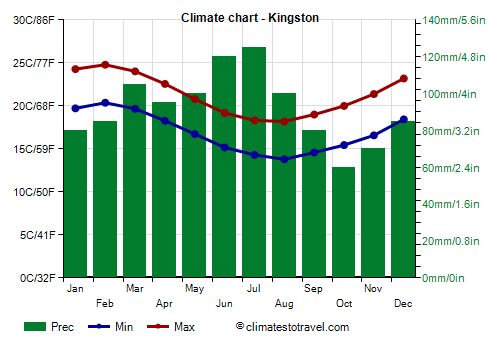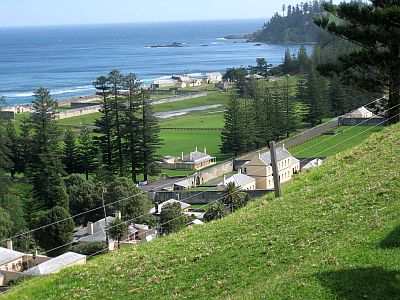Select units of measurement for the temperature and rainfall tables (metric or imperial).
Average weather, temperature, rainfall, sunshine
In Norfolk Island, the climate is
subtropical oceanic. The weather is spring-like most of the year, with frequent rain and wind, but also an acceptable amount of sunshine.
Norfolk Island is an external territory of Australia, located in the South Pacific Ocean, about 1,400 kilometers (870 miles) east of Australia and at 29 degrees south latitude.
In the north of the island there is a national park, very green and covered with hills, the highest of which is Mount Bates, 319 meters (1,017 feet) high.
The climate in detail
Temperature and rain
Kingston

In
Kingston, the capital, the average
temperature varies between 22.5 °C (72.5 °F) in February and 16 °C (61 °F) in August.
In the warmest months, January and February, the temperature is around 25 °C (77 °F) during the day and around 20 °C (68 °F) at night. In the coolest months, July and August, highs are around 18 °C (64 °F) and lows around 14 °C (57 °F).
In winter, from June to August, the westerly winds, which prevail in this season, can bring waves of
bad weather, with wind and rain.
Sometimes, from June to October, cold air masses of Antarctic origin can bring
cool periods, with lows of 10/11 °C (50/52 °F) and highs of 16/17 °C (61/63 °F).
On warmer days, the temperature typically reaches 26/27 °C (79/81 °F) from January to March. The record is 28.5 °C (83 °F).
Precipitation is relatively abundant, in fact, 1,100 millimeters (43 inches) of rain fall per year. There is no real dry season, although the rains are a bit rarer in spring and early summer, from September to January, while they are more frequent in late autumn and winter, from May to August. The rainfall records are high in all months, which means that it can sometimes rain a lot even in spring and summer.
Norfolk Island gets 2,700 hours of
sunshine per year. The sun shines mainly in the austral summer, from November to March (65-70% of the time).

Sea temperature
The temperature of the
sea is warm enough for swimming from January to April, while it becomes a bit cold in the winter months, since it goes down to 19 °C (66 °F) from July to September.
Tropical cyclones
Norfolk Island is not exactly in the path of
tropical cyclones, but sometimes, one of them can leave the tropical belt and head to the south, passing over the island before weakening in the colder southern seas. This happens from November to April, but more often from January to March.
When to go
The best time to visit Norfolk Island runs from
November to March, when the rains are less heavy, sunshine more frequent and the temperature pleasant. The warmest months, where you can also swim in the sea, are January, February and March.
However, as mentioned above, from November to April, and especially from January to March, the remnants of tropical cyclones can sometimes affect the island.
What to pack
In winter (June to August): bring spring/autumn clothes, a sweater, a jacket, and a raincoat or umbrella.
In summer (December to February): bring light clothes for the day, a scarf for the breeze, a sweatshirt and possibly a light jacket for the evening; a light raincoat or umbrella.
Climate data - Norfolk Island
| Kingston |
|---|
|
| Jan | Feb | Mar | Apr | May | Jun | Jul | Aug | Sep | Oct | Nov | Dec |
|---|
| Min temp. | 20 | 20 | 20 | 18 | 17 | 15 | 14 | 14 | 15 | 15 | 17 | 18 |
|---|
| Max temp. | 24 | 25 | 24 | 23 | 21 | 19 | 18 | 18 | 19 | 20 | 21 | 23 |
|---|
| Precip. | 80 | 85 | 105 | 95 | 100 | 120 | 125 | 100 | 80 | 60 | 70 | 85 |
|---|
| Prec. days | 8 | 9 | 9 | 10 | 12 | 13 | 14 | 12 | 9 | 8 | 7 | 7 |
|---|
| Humidity | 77% | 78% | 76% | 75% | 73% | 73% | 72% | 71% | 73% | 73% | 73% | 76% |
|---|
| Day length | 14 | 13 | 12 | 11 | 11 | 10 | 10 | 11 | 12 | 13 | 14 | 14 |
|---|
| Sun hours | 9 | 9 | 8 | 6 | 6 | 6 | 6 | 6 | 8 | 8 | 9 | 9 |
|---|
| Sea temp | 23 | 24 | 23 | 23 | 21 | 20 | 19 | 19 | 19 | 20 | 21 | 22 |
|---|